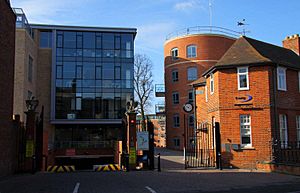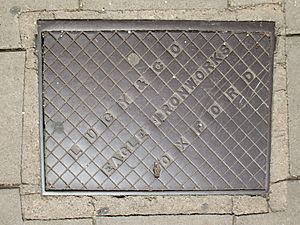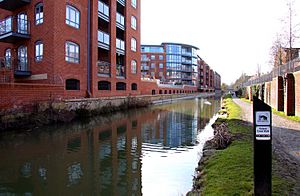Eagle Ironworks, Oxford facts for kids
The Eagle Ironworks was a large factory in Jericho, Oxford, England. It was owned by a company called W. Lucy & Co. The factory was located right next to the Oxford Canal.
William Carter started the business in 1812 with a shop. He moved the main factory to its spot by the canal in 1825. This area was on Walton Well Road and backed onto St Sepulchre's Cemetery. The factory stopped making things in 2005. It was taken down in 2007. Now, new apartments stand where the old factory used to be.
History of the Ironworks
William Carter opened his first metal shop in High Street, Oxford in 1812. He also started a metal foundry in Summertown, Oxford. A foundry is a place where metal is melted and poured into molds.
In 1825, Carter moved his foundry to the Oxford Canal. This was one of the first big buildings in the area now known as Jericho. The company was good at making things from cast iron. This included street lamps, manhole covers, fancy metal decorations, and machines for farms.
William Grafton became a partner in the business. In 1830, Carter moved away. Grafton continued to run the factory in Oxford. It then became known as the Eagle Ironworks. In 1854, the company bought the land where the factory stood.
When Grafton passed away in 1861, his partner, William Lucy, took over. After William Lucy died in 1873, the factory became known as "Lucy's".
During the Victorian era, the city of North Oxford and the University of Oxford grew a lot. This meant more customers for Lucy's. The company added new workshops and a foundry. These were designed by architect William Wilkinson and finished in 1879.
Lucy's became a "limited company" in 1897. This meant it was a bigger, more formal business. They started making more types of products. They also sold their goods all over the country. This included shelves and storage equipment. To keep up with demand, Lucy's built more parts for the Eagle Ironworks. A new factory extension was finished in 1901.
Over time, the factory started making different things. They moved into electrical engineering and working with stainless steel. They made arc lamps, parts for electric lights, and castings for steam rollers. They also made special shelving for libraries.
During both World War I and World War II, Lucy's helped by making military supplies. Between the wars, they focused on electrical engineering. They also made switchgear, which controls electric power. After World War II, they also made tools for machines.
Closing and New Buildings
In the 1960s, the company built two large buildings by the canal. In 2005, the new owners of Lucy's decided to move their manufacturing outside of the United Kingdom. So, in 2007, they tore down the Eagle Ironworks.
New apartment buildings were built on the site. The company now rents these apartments to people. Before the new buildings were constructed, experts looked at the ground. They found an old pit from the 1600s and possibly a well from the 1800s. A new road called William Lucy Way was also built nearby.
In Books
A writer named A. E. Coppard (1878–1957) worked at the Eagle Ironworks in the early 1900s. He wrote about his time there in his book It's Me, O Lord!.
The famous Oxford author Philip Pullman also mentioned the Eagle Ironworks. It appeared in his 2003 novel Lyra's Oxford. In the story, there's a made-up character named "Randolph Lucy." He was an alchemist from the 1600s. He had a laboratory on a nearby street. The book even includes a fake guide entry about the Eagle Ironworks.





